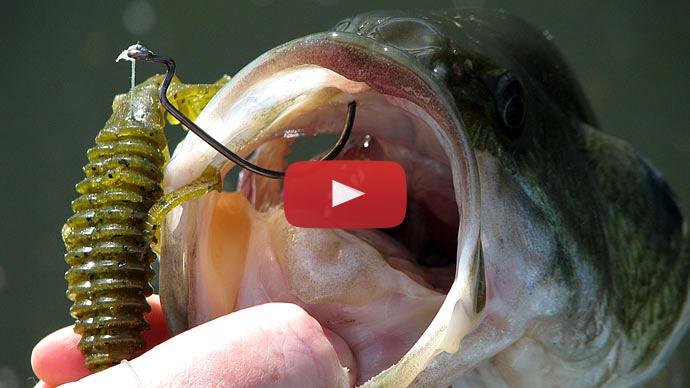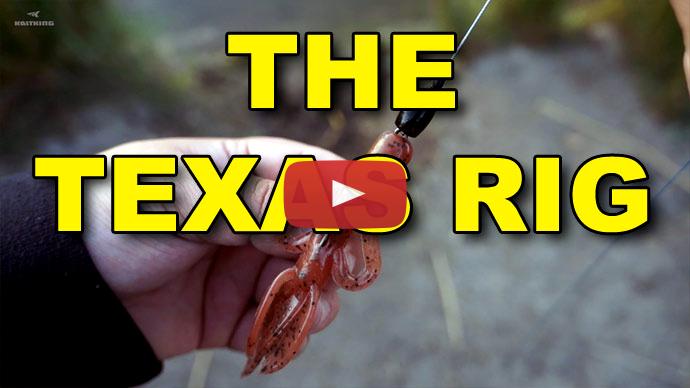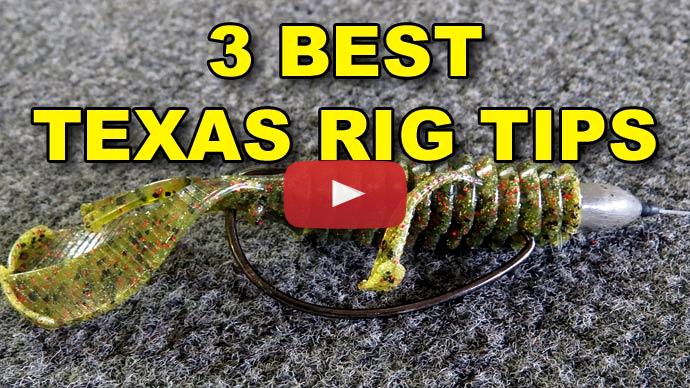Glenn: There we go. There we go. That's a good fish. Well, okay. You can net him. There we go. There we go. That works.
Keri: Take your photograph...
Glenn: Hey folks. Glenn May here with BassResource.com. Today, it's the middle of summer. It's about 100 degrees out and we're catching fish, shallow. We're fishing them, we're catching them on a variety of Texas rigs. And that's what I want to talk to you about today is catching fish on Texas rigs during the summer. So I'm gonna walk you through some of the rigs were using, why we're using them, and then I'm gonna show you how we're using them.
When you're out fishing on a day like this, I really don't know what I'm going to come across. You can come across lily pads, submerged bushes. You can come across little patches of weeds, milfoil, hydrilla, downed trees, docks. There's a whole variety of things, so you have to be prepared and have a variety of baits with you ready to fish.
My wife and I are fishing in two different ways today. One of the baits that I'm using is this, it's the Berkley Powerbait Maxscent Creature Hawg. Look at that. Great little bait. That's what I'm using. It's got ribs on the side. It's got these flappers on here that move around, vibrate, create some vibrations, and of course, it's got that Berkley Powerbait scent on it that helps attract these fish and it works great. When you're fishing through all the cover, you can get the fish's attention and they'll bite it.
And we also got what my wife is fishing, is the Berkley King Tail Maxscent Powerbait. Look at this. Look at that thing. That's some awesome bait. Let me show that to you. Again, it's got ribs on it for vibration. It's got this big ribbon tail on the end of it here.
Puts out a lot of vibration and movement and it's got the Power Bait Maxscent on it. When the fish bite that they hold on real tight. It's great, great for fishing summertime.
And you can see she's got it rigged. She doesn't have the weight pegged. It's a 3/8-ounce tungsten weight for this larger bait. This gets you down into those bushes and some of those thicker weeds. And then with what I'm fishing, as you can see a little bit lighter. I'm using a quarter ounce tungsten weight and I've got that pegged here with a Bobber Stopper.
We're using Berkley FireLine, Ultra 8 line 30 pound, which is...look at this, how thin this is. It's hard for you to even see it at the 30-pound braid works awesome. I love braided line and this is great for throwing in the bushes and the trees and in the weeds and horsing those fish out of thick cover, plus it's limber enough that I can skip under docks. I can skip it under any type of cover. Maybe if there's boats that are parked in the docks or fishing marinas that sort of thing. The line look works really well for that ultra-sensitive. Perfect for these situations.
I've also got it rigged on a Berkley... Sorry, this is an Abu Garcia. An Abu Garcia SX Reel. I love this reel. It's a 7.3:1 gear ratio. It has...the thing I really like about it a lot is the brakes on it, is the drag. It's 24 pounds of drag on it. That is super, super stout, very strong. Most reels these days come between 12 and 15 pounds of drag. Twenty four pounds of drag on this puppy. So when you've got a fish buried up in the weeds or buried up in that bush brush pile, you can yard them out really well.
Boy. Now that Maxscent did its job. He wouldn't bite it. I had to let it sit there for a while and let that do its thing and he finally grabbed it. He kept playing with it and playing with and playing with it though finally, he said, "Yeah that smells good. I think I'll eat that." Look at that. Good job.
Keri: Yeah, nice.
Glenn: Yeah, look at that belly. He's been eating...
Keri: This side of his mouth looks Weird.
Glenn: So let's talk a little bit about where to find the fish and how to catch them. You know, in the summertime, especially dog days of summer, the old thinking is that the fish, they are not even shallow. They go out deep and they sit there on the outside, main lake points, channels, points, ledges, that sort of thing. And that's true. You'll find fish out there doing that. There's no doubt about it and you can definitely fish for them.
But they don't all go that way and I really think that the under fished less pressured fish are the ones that are really shallow. What happens is in the morning and in the evening and in low light conditions, the fish are up shallow, actively feeding, moving around, and you can catch them on fast moving bait, and on topwater.
So, you know, buzz baits, spinnerbaits, crankbaits, that sort of thing. But when the sun comes up, bright overhead just like it is right now, that's when they bury up deep in this cover. Whether it be weeds, it could be milfoil or hydrilla, it could be lily pads, something like that. Or they might be in brush pile, submerged bushes, blogs. Could be some trees that have fallen over in the lake, even docks, they'll be up shallow up in there.
Why? Because that's where the baitfish go. A lot of baitfish go in there and cover to hide from the predators. And wherever the baitfish are, you'll find the bass. Really during this time of year, it's baitfish is that's going to position the bass. If the baitfish move, so will the bass. And if the baitfish stay in that area, the bass are going to stay in that area, too.
That's really important key to remember. They're not going to be out shallow at 6:00 in the morning and they're gonna go out there two miles away into a deep ledge in the afternoon. They're just not gonna swim that far. They're gonna go where the baitfish, they're going to go right up to the closest cover and bury up in there.
This is why I really liked this Berkley Creature Hawg. It's Kinda got that baitfish profile to it. And one of the things I like to do, I haven't done it on this one yet because it's brand new, but I like to dip the tails and chartreuse because we've got a lot of bluegill around here. Most of the lakes in America do, and fish, the bass really feed upon bluegill this time of year. So I like to dip the tails in chartreuse dye to kind of mimic that bluegill look. And I get a lot more bites doing it that way.
Oh, look at that. Okay, Buddy. I got you. You're not going to believe this at all. You're not gonna believe this one bit. I have to show this to the camera. He went after it and somehow the line...you guys aren't gonna believe this. The Hook is not in his mouth. It's on his mouth, but it's not hooked. It wrapped underneath him...
Keri: You caught him by the gills.
Glenn: All the way around. I lassoed him. I lassoed this... Look at this. I can show you. The Hook is...you can see it's not in his mouth. Look at this. It's loose. It came up underneath him and it's not bleeding, so I didn't hurt his gills. I just lassoed him. Is that bizarre or what? I have never ever, ever experienced that in my life of fishing. And he took my creature bait. I'll be Dang. Not a big fish, but wow, that is incredible.
So what are you gonna do? Are you gonna...you're fishing all of these different types of cover, how do you fish it, really? What I like to do is when I get up into this, especially submerged bushes and brush piles, is I'll throw up into it, but then I like to work the bait through really slowly. Kind of crawl my way through it. Just throw it up there. Let the bait fall straight down. Keep in contact with it and then reel up on it, and you've just got your line just nice and tight. So you've got a feel for it, but don't pop it up or drag it or do a whole lot of quick movements. The fish are a little slow, a little lethargic this time of year, so you gotta get it right in their face and kind of entice them to bite it.
Sometimes what I'll do is I'll get it on a limb or something on a branch, I'll just sit there and Jig it. Just Jig that bait. Just pop it, just like that. Just lift it up a little bit, jig it, and then drop it back down and let it sit for a little bit. And then lift it back up and jig it and pop it. Just shake it and let it fall right back down just to get their attention. That's all you need to do. Then drag it up over that branch and let it float back down. Slowly crawl through the next little piece and just work your way through it.
Whether it's a, you know, the different types of baits you're using, make sure that presentation works really well. One thing to pay real close attention to is the position of the fish. This sun, yeah, sure it sticks them in the weeds, puts them onto the docks, but really the way you got to think about it is not so much where the sun is, but where is the shade? Because that's where the baitfish are. That's where the bass are hiding.
So look at the shade and where that is. If you're on the shady sides of docks, that's where you want to cast and fish. If you've got a row of docks and there's one side sunny outside shady, you can skip all the sunny side part of it and just skip...and just fish the shady part. It'll be a lot faster, more efficient as you go down to lake that way. Here we go.
Keri: Well he's digging. Come on baby, where are you?
Glenn: I can't see him.
Keri: Neither can I. Here he is.
Glenn: There we go. Look at that.
Keri: That's on my brand new rod, fishing the first time with FireLine with the brand new Revo.
Glenn: So fishing in the summertime is about being flexible and versatile. Those fish are going to be in a variety of different cover and you need to be ready to fish all those different types of things. So this is why I'm rigged up with several different types of baits and my wife and I will purposely fish different kinds of lures to see what the fish are hitting, but also we're ready to change up depending on whatever cover we go to. I hope those tips help. For more tips and tricks like this, visit BassResource.com.



